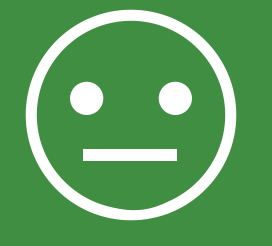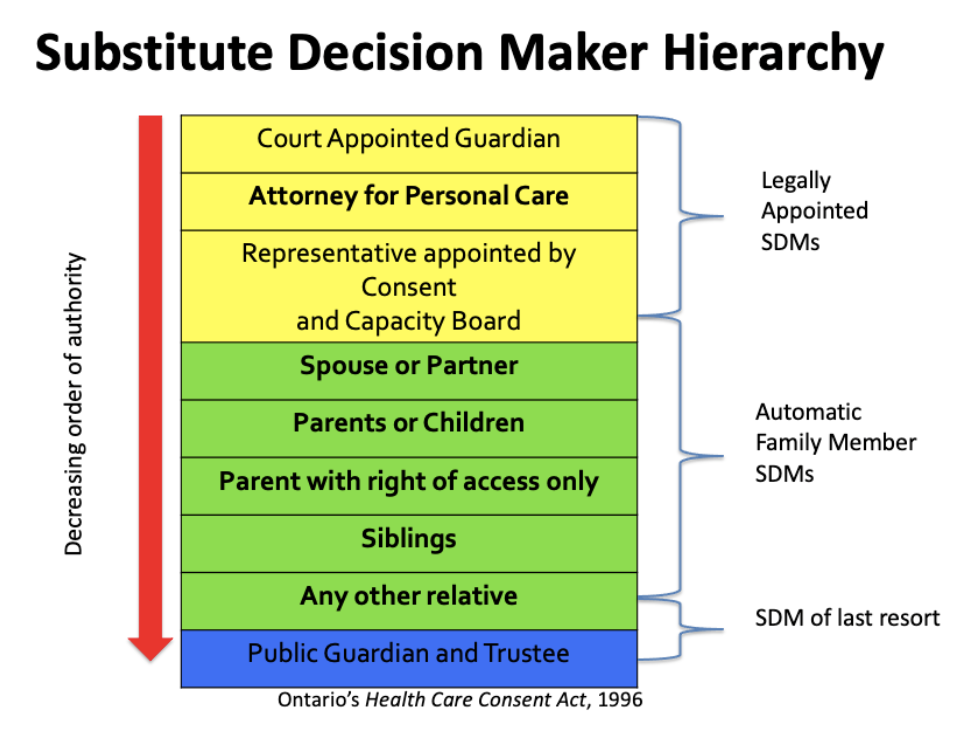Identify your SDM
Look at the coloured list to the right and determine who your SDM would be.
For an explanation of the categories, click here.
Althea's automatic SDM is her mother.
Bob has three children. They would all share the role of his SDM.
Tran's automatic SDM is her husband.
What are the rules to be a Substitute Decision-Maker?
The SDM must be:
- Willing to be your SDM and make decisions on your behalf if needed
- Available when decisions need to be made
- Capable of providing consent
- 16 years or older
- Not prohibited by court order or separation agreement
Your SDM(s) should be someone who you feel would understand and honour your wishes
Other things you might want to consider when thinking about your Substitute Decision-Maker (SDM):
- Can I talk with this person(s) about my wishes, values and beliefs?
- Do I trust this person(s) to make decisions that reflect my wishes even if they disagree with them?
- Can they make decisions under stress?
- Can they communicate clearly with my health team in a stressful manner?It’s not always possible to know what kind of future health problems you may have.
I have identified who my automatic SDM(s) would be and:

I am happy with my automatic SDM
- If you are satisfied with your automatic SDM (s), click below to complete your “My Substitute Decision-Maker” card.
- You can always come back later and access this card from the menu bar or through the ACP Workbook section of this website.
- Remember that if you have multiple SDMs at the same level, they will all need to agree on a decision.
Tran is comfortable with her husband as her automatic SDM.
My Substitute Decision-Maker Card

I would like to consider other options for my SDM
- For some people, their automatic SDM is not the person they would like making their healthcare decisions.
- In Ontario you can choose to legally appoint someone to make hour healthcare decisions instead of your automatic SDM.
- This person is called an Attorney for Personal Care.
- You may choose to appoint more than one person in this role.
Althea chose to appoint her two sisters as joint Attorneys for Personal Care instead of her mother who would be her automatic SDM.
Bob’s children do not get along. After reviewing the role of the SDM, he decides to appoint his middle son as Attorney for Personal Care.
Learn more about Attorneys for Personal Care
Frequently Asked Questions
Should I include my SDM in ACP conversations?
- It is good idea to involve your SDM as much as possible in these conversations.
- ACP is meant to prepare your SDM to make your healthcare decisions in the future if you loses capacity to make your own decisions.
- If you are not comfortable including your SDM in ACP conversations, think if there is someone else you would prefer in the role.
- Your SDM may have to make some hard choices. Knowing about the person and their values can make this easier.
Can an automatic SDM choose not to make my healthcare decisions?
Yes. Any SDM can choose not to make your healthcare decision. If this happens, your healthcare provider will ask the next person lower down on the hierarchy list to make your healthcare decision.
What if I am not happy with my automatic substitute decision-maker?
- If you are not happy with your automatic SDM, you may appoint an Attorney for Personal Care.
- You must be capable at the time you appoint an Attorney for Personal Care.
What if more than one person is at the same level on the SDM hierarchy?
- Looking at the list of people who can make decisions, a person may have more than one person at the same level (e.g children or siblings)

- If they are highest on the list, they would automatically make decisions. They must make decisions together (jointly) or decide among themselves which one will act as your SDM.
- For example, if a person has three children (#5 on the list), all three are entitled to act as SDM(s). They must act jointly and agree on any decisions for a person's health care or they can agree that only one of them will make decisions. The health professionals cannot pick which one of the three should make decisions. The three children must decide among themselves whether they will all act together or if only one of them will.
What is the difference between an Attorney for Personal Care and an SDM?
An Attorney for Personal Care (POAPC) is one type of SDM. They are the second highest on the list of SDMs.

What is the difference between an Attorney for Personal Care and an Attorney for Property?
- A Power of Attorney for Personal Care ONLY gives the person the ability to make decisions about healthcare. They cannot make decisions about your property or finances.
- For property and finances, a person must prepare a Power of Attorney for Property.
- A person does not need to choose the same person for both. Each is appointed in a separate document.
- For more information:
What if SDM(s) disagree amongst themselves?
If people who are equally entitled to act as SDM(s) cannot agree on the decisions about your treatment, you may have several options depending on your clinical setting:
- Make sure you have explored the underlying illness understanding and underlying reasons behind the disagreement as there may misunderstandings that are leading to the issue.
- If you have access to bioethics consultation, they may be able to support the SDM(s) to reach consensus.
- If you cannot reach agreement among the SDM(s), the Public Guardian and Trustee is required to act as SDM. The Public Guardian and Trustee does not choose between the disagreeing decision-makers but makes the decision instead.
Where would you like to go next?: